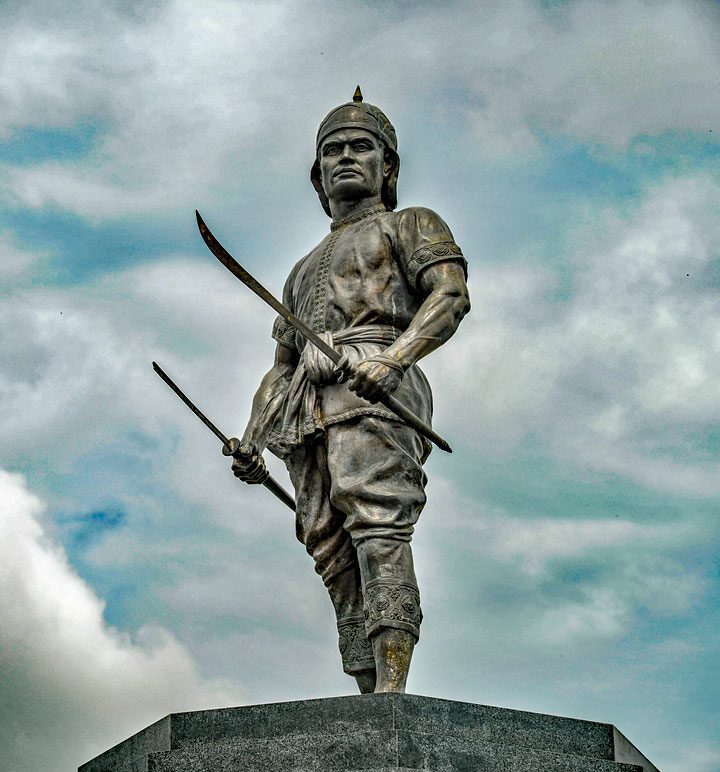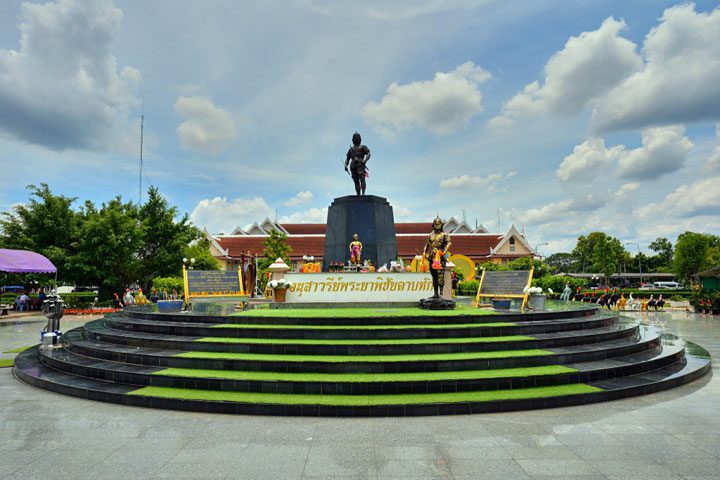The life of Phraya Phichai Dap Hak
In front of Uttaradit City Hall is a statue of Phraya Phichai Dap Hak (Phraya Phichai of the Broken Sword), a general, who served as both the left and right hand under King Tak Sin in fighting the Burmese forces. This is his life story.
childhood
During the late Ayutthaya period, around the year 1750, a boy named Choi lived in Phichai district of Uttaradit province. Choi was intelligent and not afraid of anyone. Although small in stature, he was not easily intimidated and often fought with bigger children. He loved boxing and other martial arts. When Choi was eight years old, his father sent him to the Mahathat Temple in Pichai for his education. In that temple he learned to read and write and every day after classes he practiced boxing. He used a banana tree as his attack target, on which he had hung small lemons to kick away with his feet. His passion for boxing was unparalleled.
One day, the governor of Phichai visited the Mahathat Temple with his son, whom he also wanted to be raised by the abbot of the temple. Choi and that son did not get along, which resulted in a fistfight. Choi was the victor when he knocked that son to the ground. However, he was afraid that he would get into trouble now and Choi fled from the temple.
On the way to Tak
On his flight to the north, he met a boxing master named Thiang, who was willing to further train Choi in the sport of boxing in exchange for odd jobs. Since this was a new life for him, Choi changed his name to Thongdee. When he was 18 years old, Thongdee was an excellent boxer. He now taught boxing to other young people and participated in all kinds of boxing competitions.
One day, a Chinese traveler, on his way to Tak province, stayed overnight at Thongdee's camp. He was very impressed with Thongdee's skills and invited him to travel to Tak with him. The traveler told that Phraya Tak Sin, the governor of Tak, had a passion for boxing. He promised Thongdee to put him in touch with the governor.
At the next boxing tournament organized by the governor, Thongdee took part in a fight against some of Tak's best boxers. To everyone's surprise, young Thongdee won several matches by knockout. Phraya Tak Sin was very impressed with the young boy's talent and he promised to employ Thongdee.
Thongdee was grateful for the opportunity to serve the governor and quickly became one of Tak Sin's favorite officers. When Thongdee turned 21 years old, Phraya Tak Sin bestowed upon him the title of Luang Phichai Asa. Thongdee was now responsible for training Phraya Tak's soldiers. .
Burmese attack
In 1765, Ayutthaya was attacked by Burmese troops and King Ekkathat desperately tried to defend his country against the invaders. The king asked Phraya Tak Sin to support him, but he had considered the situation and believed his efforts would prove futile. The general left the city with five hundred of his best warriors, including Luang Phichai Asa, making sure they were not discovered by the enemy.
When the Burmese realized they had let Taksin and his men escape, they sent an army in pursuit. The two armies clashed at Pho Sao Harn, where the Burmese were first introduced to the general's ferocity. Tak Sin's forces repulsed the attack, pursued and killed the Burmese troops, capturing many weapons. Several more battles ensued and Tak Sin's troops always came out victorious. These victories gave new hope to the Siamese people and many men enlisted in Tak Sin's army.
Campaign to the East
Tak Sin knew that his troops were not yet strong enough to attack the Burmese. He needed more men and the only way was to get help from the Siamese governors of the eastern cities, who had escaped the Burmese onslaught during the 1766 invasion. He moved east, fought another battle at Nakhon Nayok, marched past Chachoensao, Banglamung and finally reached Rayong.
Rayong's governor welcomed Tak Sin to his city and offered his troops to reinforce him. But there were some Rayong nobles who disagreed with the governor's decision. They believed that if the governor of Rayong helped Tak Sin, the Burmese troops would not spare their city if they gave chase. The assembled nobles decided to get rid of Tak Sin and formed a large army, which surrounded Tak Sin's camp. However, Tak Sin's men were well prepared and in the first attack, Taksin's men killed the opponent's first line.
The ranks were confused by this shelling and Luang Phichai took the opportunity to nab 15 conspirators.

Guerrilla war
Luang Phichai Asa was known for his signature fighting style of fighting with two swords, one in each hand. He cut off the conspirators' heads and threw the heads at Tak Sin's feet as a trophy. That night, Tak Sin captured the city of Rayong.
This was followed by Chantaburi (the siege of Chantaburi is a separate story, which will follow later), where Phraya Tak Sin stayed for several months to strengthen his army. He made Luang Phichai his captain of the troops. He then declared war on Burma to bring about freedom for the Siamese people. to liberate Siam.
Phray Tak Sin waged a sort of guerrilla war with the Burmese, retaking many small towns and villages from the Burmese. In 1773, the city of Phichai was attacked by the Burmese general Bo Supia. The counterattack was led by Luang Phichai. The battle took place near Wat Aka and the Burmese general was forced to retreat after suffering significant casualties.
The broken sword
In the heat of battle, Luang Phichai fought with “Song ma dap”, meaning a sword in each hand. In one of those fights he slipped and he used a sword to prop himself up and planted the sword in the ground. That sword broke under the weight of Lung Phichai. Nevertheless, he won the fight and was nicknamed Phraya Phichai Dap Hak because of this.
Liberation
Finally, after a 15-year struggle, Siam was liberated from the Burmese and Tak Sin was crowned king. King Tak Sin died in 1782. The life of Luang Phichai parallels that of King Tak Sin for a long time and Tino Kuis recently posted a well-documented story about him on this blog, see www.thailandblog.nl/historie/koning-taksin-een-fascinerende-figure
The end of Luang Phichai
The new king, Rama 1 of the Chakri dynasty, wanted to reward Luang Phichai for his loyalty and merits and offered him to continue his good work as his bodyguard. That in itself was surprising, because it was customary at the time for bodyguards and loyal servants of a deceased king to also die with him.
Luang Phichai refused the offer. He was so affected by the death of his beloved king that he ordered his execution also. Instead, he requested that the king take care of and train his son. That was accepted and that son indeed later became the personal bodyguard of King Rama 1. Phraya Luang Phichai died at the age of 41.
The monument
The monument of Phraya Phichai was built in 1969. The bronze statue of the great warrior stands proudly in front of the city hall in Uttaradit and serves to remind each generation of the bravery and loyalty to its king and the Siamese nation. The text on the memorial reads “In memory and loving honor to the pride of our nation”.
Movie
A Thai film has also been made about this warrior, “Thong Dee, the warrior”.
The trailer can be found below:
Source: Phuket Gazette/Wikipedia



The Thai soil and Thai palaces are soaked in blood.
In Pichai there is a beautiful replica of the house of Phraya Phichai Dap Hak. A beautiful traditional wooden house on stilts. Not only historically, but also architecturally interesting.
A little further down the historic site there is a small museum that shows the exploits of the warrior and his people.
Completely free to visit, even for the farrang 🙂 You hardly see them there, unlike the Thai lovers of "classical history".
Maybe the dear readers will like it, and I can practice my Thai again. The correct pronunciation is in brackets.
Dap Hak, ดาบหัก (dàap hàk, so two low tones)
The various non-hereditary, old official titles from lowest to highest:
ขุน Khun (khǒen, rising tone, not to be confused with khoen, mean tone: sir/madam)
หลวง Luang (lǒeang)
พระ Phra (phrá, so high tone)
พระยา Phraya (phraya)
เจ้าพระยา Chao Phraya (châo phráyaa)
Phichai พิชัย (phíechai) means (winning) war strategy. Chai is victory, found in endless Thai names.
Tino about those titles, they are sometimes translated a bit freely, aren't they? For example, in the Darapirom museum in Chiang Mai you noticed a difference between the English title (governor?) and the one in Thai. Can you say something about that?
No idea Rob. 'Governor' is a position and it used to have different titles depending on seniority and origin, although usually the higher ones. From Luang Phichai to Phraya Phichai for example.